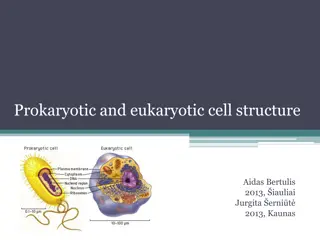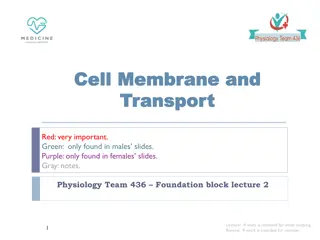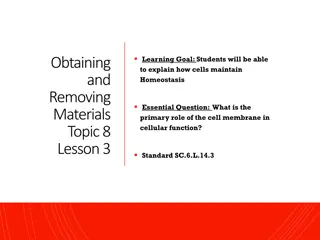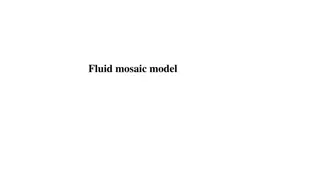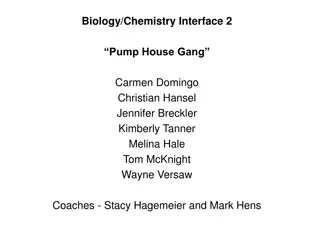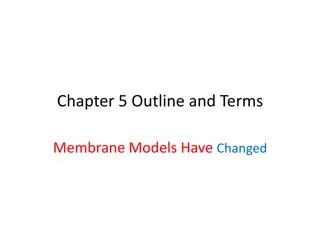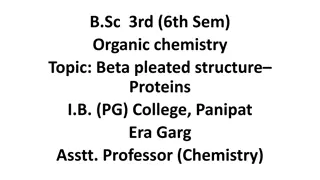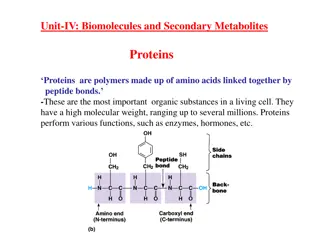Understanding Cell Membrane Structure and Proteins
Exploring the basic structure of membranes, the distribution of proteins within the membrane, intrinsic vs. extrinsic proteins, the fluid mosaic model, phospholipids forming the bilayer, the role of hydrophilic and hydrophobic parts in phospholipids, polysaccharides, and the differences between glycoproteins and glycolipids.
Download Presentation

Please find below an Image/Link to download the presentation.
The content on the website is provided AS IS for your information and personal use only. It may not be sold, licensed, or shared on other websites without obtaining consent from the author. Download presentation by click this link. If you encounter any issues during the download, it is possible that the publisher has removed the file from their server.
E N D
Presentation Transcript
Cells and Organelles; The Cell Membrane Book Reference: p.16-p.19
Do all membranes have the same basic structure? Both the cell surface membrane and the membranes surrounding certain organelles have the same basic structure. Much of the membrane is made up of a 'sea' of phospholipids with protein molecules 'floating' in between the phospholipids.
Where are proteins located within the membrane? What is an intrinsic protein? What is an extrinsic protein? Why is it called the fluid mosaic model?
INTRINSIC 1: Channel Proteins Allow movement of substances, such as glucose, across the membrane NO ATP REQUIRED
INTRINSIC 2: Carrier Proteins Actively transport substances, such as minerals, across the membrane ATP is REQUIRED
(a) Channel VS (b) Carrier Proteins
Bilayer; Phospholipids What is the bilayer? The phosphate heads are polar molecules and so are water-soluble. The lipid tails are non-polar and therefore are not water-soluble.
Why do phospholipids have both a hydrophilic and a hydrophobic part? The phosphate heads are polar. Are they water-soluble? The lipid tails are non-polar. Are they water-soluble?
What is a polysaccharide? Clue: polymer; monomer; carbohydrate
What is the difference between a glycoprotein and a glycolipid? Glyco what?
What is the role of glycoproteins? They may help in the recognition of, and interaction with, other cells. They may also play a part in the recognition of hormones and foreign molecules.
What is the role of cholesterol in the cell membrane? Cholesterol is also present in the membrane. It maintains the fluidity and increases the stability of the membrane. Without cholesterol the membrane would easily split apart
Cell membrane: Functions 1. Selectively permeable barrier. 2. Structural, keeping the cell contents together. 3. Allows communication with other cells. 4. Allows recognition of other external substances. 5. Allows mobility in some organisms, e.g. amoeba. 6. The site of various chemical reactions.
Cells and Organelles; Tissues Some organisms do exist as single cells - for example, Amoeba, but many organisms are multicellular and consist of from hundreds to billions of cells. The functions of the organism are divided up amongst the groups of cells, which become specialised for particular roles. Specialised cells show division of labour by being grouped into tissues.
What is a Tissue? Definition A tissue is defined as a collection of cells, together with any extracellular secretion, that is specialised to perform one or more particular function. Tissues may contain only one type of cell, or several types.
Website Reference: www.s-cool.co.uk go to Biology and then: 1.Cells and Organelles 2.Gas Exchange 3.Transport
This powerpoint was kindly donated to www.worldofteaching.com http://www.worldofteaching.com Is home to well over a thousand powerpoints submitted by teachers. This a free site. Please visit and I hope it will help in your teaching



